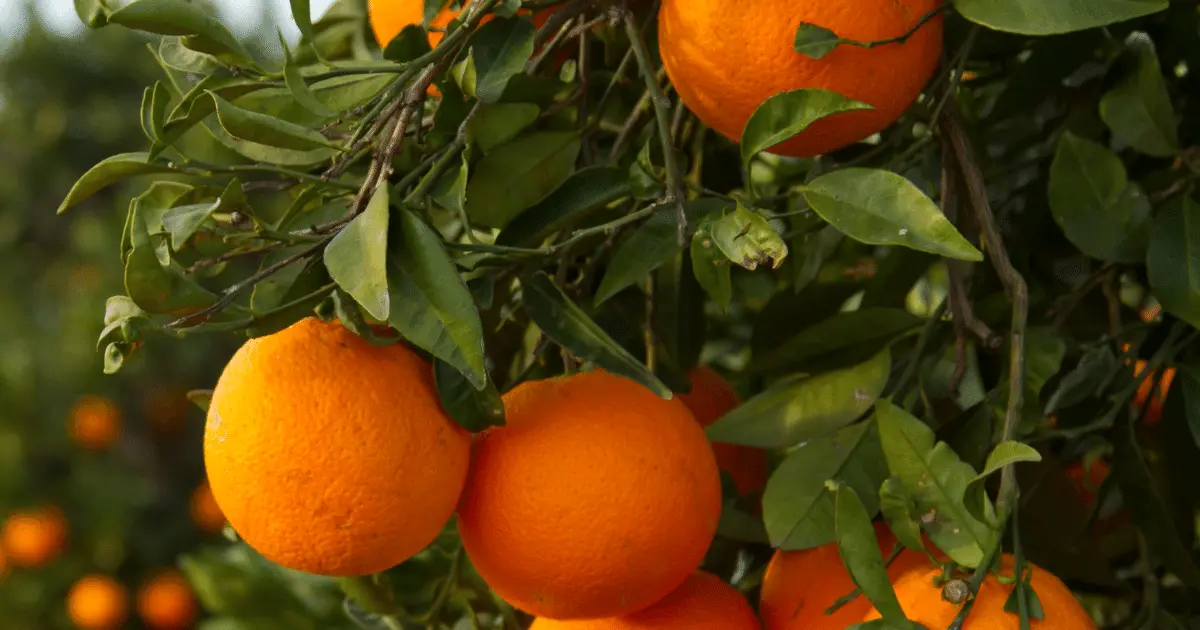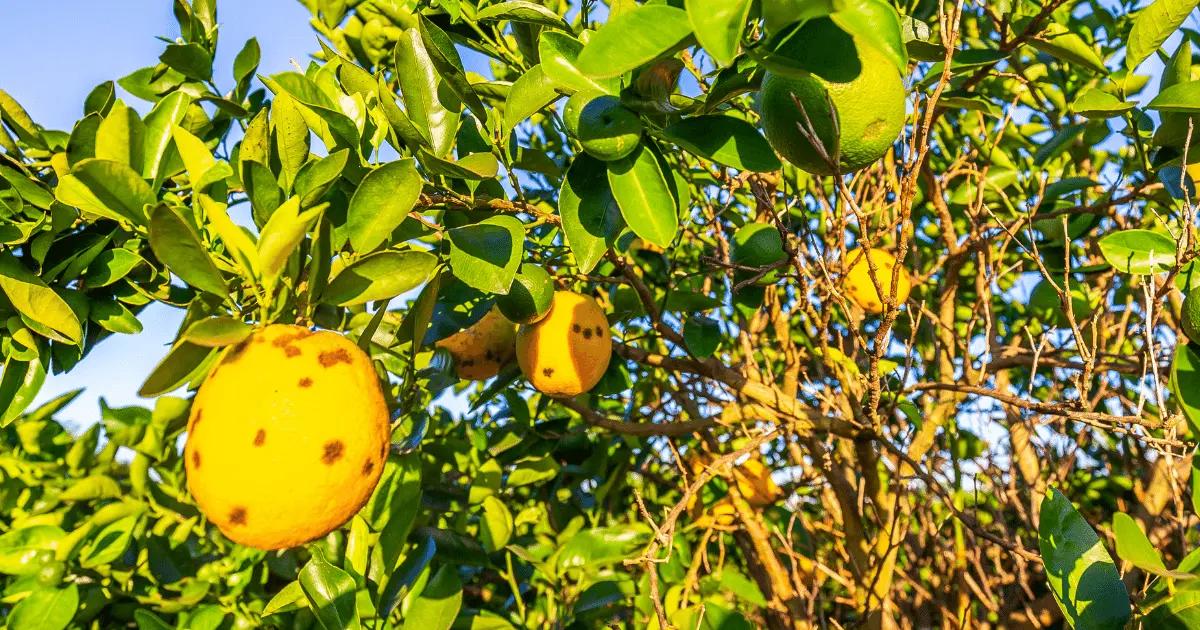Orange plants are a stunning addition to any house; they add lush greenery, yellow fruits, and the fragrance of orange to your home when grown indoors. Because they are attractive and bright, they can immediately transform a dreary space into something thrilling, bright, beautiful, and lovely.
Citrus is an evergreen tree in the Rutaceae family grown for its edible sweet fruit. Oranges come in different varieties, including Naval orange and blood orange; the orange tree has rounded leaves alternately distributed on the branches.
What Causes Of Orange Tree Leaves Curling, And How To Fix It?

When an orange tree receives insufficient water, attacked by fungus disease, pests, and extreme weather, its leaves frequently curl. Given that orange trees’ leaves can curl for several reasons, how can you identify the problem that your tree is having, and how can you resolve it?
Some of the reasons and solution to orange leaves curling includes;
1. Under/Over Watering
Underwatering is the most frequent cause of curled leaves on orange trees. Orange tree leaves will eventually curl to retain moisture when they are not given enough water.
Due to their preference for growing in hotter, tropical settings with more evaporation and humidity, orange trees frequently require more water than other fruiting trees.
How To Fix It
There is a handy approach to determine whether you’re overwatering or underwatering your orange tree.
Water orange trees whenever the top 2-4 inches of soil get dry; 2-4 inches of soil beneath that drip line of the orange tree should be probed with a finger. Your tree needs additional water if the soil is completely dry.
The plant needs less water if the soil is completely saturated for more than one hour after watering.
So, check the soil’s moisture before watering your orange tree by poking a finger into it. Ensure the orange tree receives only the right amount of water by watering whenever the soil is completely dry.
2. Lack of Drainage
While too much water will restrict airflow, too much air will result in insufficient moisture or water.
Things become considerably more challenging when plants are grown in pots; drainage is crucial for potted plants.
There are two types of drainage issues you ought to prevent:
A lack of water movement or poor drainage.
Excessive drainage or excessive water flow results in water loss.
How To Fix It
However, waterlogged orange trees in pots can be replanted in new potting soil, which could lead to transplant shock.
If the soil around your orange tree is still drenched in water an hour or more after you water it, enrich the soil using 2 inches of soil, mulch, and compost to enhance drainage. It may take some time, but it’s preferable to risk transplant shocks by uprooting established orange roots.
Importance Of Mulch To Plants
Mulch is an excellent technique to recycle organic materials and aids in reducing weed development. Mulches incorporate organic matter into the soil, a nutrient and water storage area below ground.
Mulch prevents soil from drying out due to the sun and wind by significantly reducing evaporation from the soil. This water retention is useful, particularly in hotter tropical climes, where orange trees thrive.
Mulch aids in water retention; mulch greatly lowers the evaporation from the soil, preventing soil from drying out due to heat and wind. This water retention is very helpful, especially in tropical climates with higher temperatures where orange trees flourish.
Mulches encourage rainwater to percolate more easily by spreading it out above the soil and slowing it down. In this manner, the soil structure is preserved while the roots continue to receive the water they require.
You can mulch orange trees with leaves, chopped wood bark, straw, pine needles, and grass clippings.
3. Weather issues
Extreme heat, and extreme cold cause orange tree leaves to curl. Orange trees typically thrive in a range of 35°F to 90°F, and they can become stressed when their temperature varies from this.
Cold Weather
On orange trees, leaf curl is less likely to occur during cold weather, although it is still possible. Orange trees tend to be more resilient than that other citrus trees; however, freezing weather can strain the tree and result in curled leaves.
How To Fix It
During frosty weather, protect orange trees by doing this;
Orange trees in pots can be taken inside or placed in the ground, while planted orange trees can be wrapped in cardboard or bed sheets. Avoid bringing it inside and placing it next to the furnace since it will dry your tree and its leaves.
Plant along a wall that faces south to reflect warmth and sunlight onto the tree; the wall radiates heat even at night.
Hot Weather
Orange trees are harmed by hot, dry weather because the leaves shrivel up before the roots can replenish moisture. The leaves become burned and curl to retain moisture when this occurs.
In dry weather, compost and mulch while are excellent habits to have in general; hot and dry weather makes them even more useful.
The leaves will wither and fall off the trees if it is hot for too long.
How To Fix It
You can fix Orange plant heat condition issues by;
- Provide Enough Watering.
- In the heat, plants, especially outdoors, become thirsty. At the base of the plant, give them a deep watering. Deep watering entails soaking the soil to a depth of roughly a foot, which stimulates roots to go further into the cooler soil.
- Provide Shade.
- When the sun is fiercest in the afternoon,
provide shade. If it is indoors, you can close the curtains, and when outdoors, you can build a shade or block sun rays with objects such as umbrellas, big cartons, etc. If feasible, provide shade from the west because we shield the tree from midday light. - Provide Cooler Indoor Temperature
- Even indoor temperatures might change when it’s extremely hot outside. Ensure that those who prefer cooler interior temperatures are in properly air-conditioned spaces.
4. Lack of Nutrition.
Iron and potassium deficiencies might lead your orange trees to curl and turn yellow. Oranges prefer a pH in the range of 6-7, and these deficiencies happen when the pH of the soil is too high. Before fruiting, oranges require an extra dose of balanced fertilizer.
How To Fix It
Give your tree an excellent, well-balanced orange fertilizer with a high potassium content, and watch out not to treat it with too much nitrogen.
Apply some coffee grounds to the soil to organically address the issue of leaf curl. It will function as an organic potassium fertilizer. Also, some nitrogen and phosphorus will be released from the coffee grounds.
5. Pest And Disease

Diseases can affect any living thing, even fruit trees. When developing and caring for orange trees, you want to protect them from these diseases that attack orange plants by killing and contaminating the fruit and the tree.
For pests, you might also see a black fungus sprouting on the leaves of your citrus trees, an indicator that your plants are already experiencing insect infestation, like bugs, mealybugs, aphids, and scales.
This fungus enjoys the sticky stuff that the insects make and feeds on it, which may help explain why the leaves of your oranges plant curl.
Orange plant diseases are numerous, and various factors can cause them; one of them is pests.
How To Fix It
Add compost and mulch at least 2 – 3 inches away from the tree’s trunk to stop the spread of mold and disease. Also, spray a constant or heavy stream of water laced with soap.
6. Transplant Shock
Transplant shock is probably to blame if an orange tree has recently been repotted or transplanted and has curled leaves. When a plant is transplanted, it experiences transplant shock because its root system must adapt to a new environment.
Orange trees can experience transplant shock, much as many other plants.
How To Properly Transplant
- Prepare the new soil and new pot.
- Take as much of the tree’s current topsoil as you can without harming its shallow roots should be removed.
- Take the root ball and hold it with your other hand.
- Place your tree gently inside the new soil and pot, then fill it in.
- Verify that the soil on the trunk is on the same level as before.
- Mulch the soil and add 2 inches of fertilizer on top.
- Generously water the soil, and add more as necessary.
The stress caused by transplantation shock will be diminished or eliminated if you avoid breaking or harming the roots and keep the orange tree comfy during the move.
How To Fix It Transplant Shock
1. Keep the Roots Moist
The plant may experience lasting shock if the root ball is allowed to dry up. Wrap the root ball in a moist burlap cloth to prevent it from drying out, and mist the plant every few minutes when it isn’t buried to prevent rot.
2. Water It
After being initially replanted, irrigating a transplanted plant well, taking the roots down, and distributing them out will assist the plant in establishing itself and its roots in its new environment.
Orange plants need adequate care to avoid curling of their leaves under stress or being affected by conditions such as over-watering, transplant shock, unfavorable weather, pests, and disease.
Examining the tree and its surroundings will help you find the problem and, perhaps, save the tree. If you do notice that more orange leaves are curling, identify the issue immediately and fix it quickly.
